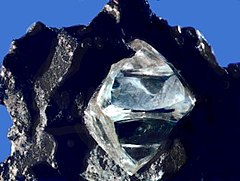Material properties of diamond
| Diamond | |
|---|---|

An octahedral diamond crystal in matrix
|
|
| General | |
| Category | Native Nonmetal, Mineral |
|
Formula (repeating unit) |
Carbon (C) |
| Crystal system |
Diamond cubic (a = 3.56683 Å) |
| Identification | |
| Color | Most often colorless to yellow or brown. Rarely pink, orange, green, blue, gray, or red. |
| Crystal habit | Octahedral, cubo-octahedral, spherical or cubic |
| Cleavage | Octahedral; perfect and easy |
| Fracture | Conchoidal |
| Mohs scale hardness | 10 |
| Streak | white |
| Diaphaneity | Clear to not |
| Specific gravity | 3.516–3.525 |
| Refractive index | 2.417 |
| Pleochroism | None |
| Fusibility | Burns above 700 °C in air. |
| Solubility | Resistant to acids, but dissolves irreversibly in hot steel |
| Major varieties | |
| Ballas | Spherical, radial structure, cryptocrystalline, opaque black |
| Bort | Poorly formed, cryptocrystalline, shapeless, translucent |
| Carbonado | Massive, microcrystalline, opaque black |
Diamond is the allotrope of carbon in which the carbon atoms are arranged in the specific type of cubic lattice called diamond cubic. Diamond is an optically isotropic crystal that is transparent to opaque. Owing to its strong covalent bonding, diamond is the hardest naturally occurring material known. Yet, due to important structural weaknesses, diamond's toughness is only fair to good. The precise tensile strength of diamond is unknown, however strength up to 60 GPa has been observed, and it could be as high as 90–225 GPa depending on the crystal orientation. The anisotropy of diamond hardness is carefully considered during diamond cutting. Diamond has a high refractive index (2.417) and moderate dispersion (0.044) properties which give cut diamonds their brilliance. Scientists classify diamonds into four main types according to the nature of crystallographic defects present. Trace impurities substitutionally replacing carbon atoms in a diamond's crystal structure, and in some cases structural defects, are responsible for the wide range of colors seen in diamond. Most diamonds are electrical insulators but extremely efficient thermal conductors. Unlike many other minerals, the specific gravity of diamond crystals (3.52) has rather small variation from diamond to diamond.
...
Wikipedia
